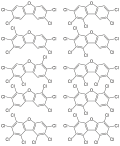Polychlorinated dibenzofurans
Polychlorinated dibenzofurans (PCDFs) are a group of organic compounds that are produced during the combustion of various materials, particularly certain plastics. They are highly toxic and are considered to be carcinogenic.
Overview[edit]
PCDFs are a group of polyhalogenated compounds that have been widely used in industry due to their chemical stability and resistance to degradation. They are produced during the combustion of chlorine-containing materials, such as PVC and other plastics. PCDFs are highly toxic and have been linked to a variety of health problems, including cancer, endocrine disruption, and developmental problems in children.
Health Effects[edit]
PCDFs are highly toxic and can cause a variety of health problems. They are known to be carcinogenic and have been linked to a variety of cancers, including lung cancer, non-Hodgkin lymphoma, and soft tissue sarcoma. PCDFs can also disrupt the endocrine system, leading to a variety of health problems, including reproductive problems and developmental problems in children.
Exposure[edit]
People can be exposed to PCDFs through a variety of routes, including inhalation, ingestion, and skin contact. The most common route of exposure is through the diet, as PCDFs can accumulate in the food chain. People can also be exposed to PCDFs through occupational exposure, particularly in industries that involve the combustion of chlorine-containing materials.
Regulation[edit]
Due to their toxicity, PCDFs are regulated by a variety of international agreements and regulations. These include the Stockholm Convention on Persistent Organic Pollutants, which aims to eliminate or restrict the production and use of PCDFs.
See Also[edit]
References[edit]
<references />
Ad. Transform your life with W8MD's Budget GLP-1 injections from $75


W8MD offers a medical weight loss program to lose weight in Philadelphia. Our physician-supervised medical weight loss provides:
- Weight loss injections in NYC (generic and brand names):
- Zepbound / Mounjaro, Wegovy / Ozempic, Saxenda
- Most insurances accepted or discounted self-pay rates. We will obtain insurance prior authorizations if needed.
- Generic GLP1 weight loss injections from $75 for the starting dose.
- Also offer prescription weight loss medications including Phentermine, Qsymia, Diethylpropion, Contrave etc.
NYC weight loss doctor appointmentsNYC weight loss doctor appointments
Start your NYC weight loss journey today at our NYC medical weight loss and Philadelphia medical weight loss clinics.
- Call 718-946-5500 to lose weight in NYC or for medical weight loss in Philadelphia 215-676-2334.
- Tags:NYC medical weight loss, Philadelphia lose weight Zepbound NYC, Budget GLP1 weight loss injections, Wegovy Philadelphia, Wegovy NYC, Philadelphia medical weight loss, Brookly weight loss and Wegovy NYC
|
WikiMD's Wellness Encyclopedia |
| Let Food Be Thy Medicine Medicine Thy Food - Hippocrates |
Medical Disclaimer: WikiMD is not a substitute for professional medical advice. The information on WikiMD is provided as an information resource only, may be incorrect, outdated or misleading, and is not to be used or relied on for any diagnostic or treatment purposes. Please consult your health care provider before making any healthcare decisions or for guidance about a specific medical condition. WikiMD expressly disclaims responsibility, and shall have no liability, for any damages, loss, injury, or liability whatsoever suffered as a result of your reliance on the information contained in this site. By visiting this site you agree to the foregoing terms and conditions, which may from time to time be changed or supplemented by WikiMD. If you do not agree to the foregoing terms and conditions, you should not enter or use this site. See full disclaimer.
Credits:Most images are courtesy of Wikimedia commons, and templates, categories Wikipedia, licensed under CC BY SA or similar.
Translate this page: - East Asian
中文,
日本,
한국어,
South Asian
हिन्दी,
தமிழ்,
తెలుగు,
Urdu,
ಕನ್ನಡ,
Southeast Asian
Indonesian,
Vietnamese,
Thai,
မြန်မာဘာသာ,
বাংলা
European
español,
Deutsch,
français,
Greek,
português do Brasil,
polski,
română,
русский,
Nederlands,
norsk,
svenska,
suomi,
Italian
Middle Eastern & African
عربى,
Turkish,
Persian,
Hebrew,
Afrikaans,
isiZulu,
Kiswahili,
Other
Bulgarian,
Hungarian,
Czech,
Swedish,
മലയാളം,
मराठी,
ਪੰਜਾਬੀ,
ગુજરાતી,
Portuguese,
Ukrainian



